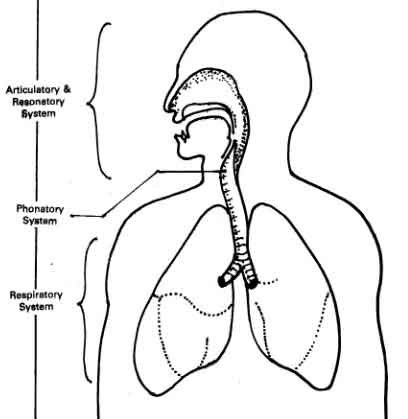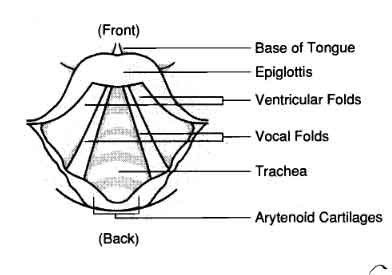Overview of Speech Production and Speech Mechanism: Communication is a fundamental aspect of human interaction, and speech production is at the heart of this process. Behind every spoken word lies a series of intricate steps that allow us to convey our thoughts and ideas effectively. Speech production involves three essential levels: conceptualization, formulation, and articulation. In this article, we will explore each level and understand how they contribute to the seamless flow of communication.
Overview of Speech Production
Speech Production deals in 3 levels:
- Conceptualization
- Formulation
- Articulation
Speech production is a remarkable process that involves multiple intricate levels. From the initial conceptualization of ideas to their formulation into linguistic forms and the precise articulation of sounds, each stage plays a vital role in effective communication. Understanding these levels helps us appreciate the complexity of human speech and the incredible coordination between the brain and the vocal tract. By honing our speech production skills, we can become more effective communicators and forge stronger connections with others.

Steps of Speech Production
Conceptualization
Conceptualization is the first level of speech production, where ideas and thoughts are born in the mind. At this stage, a person identifies the message they want to convey, decides on the key points, and organizes the information in a coherent manner. This process is highly cognitive and involves accessing knowledge, memories, and emotions related to the topic.
During conceptualization, the brain’s language centers, such as the Broca’s area and Wernicke’s area, play a crucial role. The Broca’s area is involved in the planning and sequencing of speech, while the Wernicke’s area is responsible for understanding and accessing linguistic information.
For example, when preparing to give a presentation, the conceptualization phase involves structuring the content logically, identifying the main ideas, and determining the tone and purpose of the speech.
Formulation
The formulation stage follows conceptualization and involves transforming abstract thoughts and ideas into linguistic forms. In this stage, the brain converts the intended message into grammatically correct sentences and phrases. The formulation process requires selecting appropriate words, arranging them in a meaningful sequence, and applying the rules of grammar and syntax.
At the formulation level, the brain engages the motor cortex and the areas responsible for language production. These regions work together to plan the motor movements required for speech.
During formulation, individuals may face challenges, such as word-finding difficulties or grammatical errors. However, with practice and language exposure, these difficulties can be minimized.
Continuing with the previous example of a presentation, during the formulation phase, the speaker translates the organized ideas into spoken language, ensuring that the sentences are clear and coherent.
Articulation
Articulation is the final level of speech production, where the formulated linguistic message is physically produced and delivered. This stage involves the precise coordination of the articulatory organs, such as the tongue, lips, jaw, and vocal cords, to create the specific sounds and speech patterns of the chosen language.
Smooth and accurate articulation is essential for clear communication. Proper articulation ensures that speech sounds are recognizable and intelligible to the listener. Articulation difficulties can lead to mispronunciations or speech disorders, impacting effective communication.
In the articulation phase, the motor cortex sends signals to the speech muscles, guiding their movements to produce the intended sounds. The brain continuously monitors and adjusts these movements to maintain the fluency of speech.
For instance, during the presentation, the speaker’s articulation comes into play as they deliver each sentence, ensuring that their words are pronounced correctly and clearly.
Overview of Speech Mechanism

Speech Sub-system
The speech mechanism is a complex and intricate process that enables us to produce and comprehend speech. The speech mechanism involves a coordinated effort of speech subsystems working together seamlessly. Speech Mechanism is done by 5 Sub-systems:
- Respiratory System
- Phonatory System
- Resonatory System
- Articulatory System
- Regulatory System
I. Respiratory System
Respiration: The Foundation of Speech
Speech begins with respiration, where the lungs provide the necessary airflow. The diaphragm and intercostal muscles play a crucial role in controlling the breath, facilitating the production of speech sounds.
II. Phonatory System
Phonation: Generating the Sound Source
Phonation refers to the production of sound by the vocal cords in the larynx. As air from the lungs passes through the vocal cords, they vibrate, creating the fundamental frequency of speech sounds.
Phonation, in simple terms, refers to the production of sound through the vibration of the vocal folds in the larynx. When air from the lungs passes through the vocal folds, they rapidly open and close, generating vibrations that produce sound waves. These sound waves then resonate in the vocal tract, shaping them into distinct speech sounds.
The Importance of Phonation in Speech Production
Phonation is a fundamental aspect of speech production as it forms the basis for vocalization. The process allows us to articulate various speech sounds, control pitch, and modulate our voices to convey emotions and meaning effectively.
Mechanism of Phonation

Phonatory System
Vocal Fold Structure
To understand phonation better, we must examine the structure of the vocal folds. The vocal folds, also known as vocal cords, are situated in the larynx (voice box) and are composed of elastic tissues. They are divided into two pairs, with the true vocal folds responsible for phonation.
The Process of Phonation
The process of phonation involves a series of coordinated movements. When we exhale, air is expelled from the lungs, causing the vocal folds to close partially. The buildup of air pressure beneath the closed vocal folds causes them to be pushed open, releasing a burst of air. As the air escapes, the vocal folds quickly close again, repeating the cycle of vibrations, which results in a continuous sound stream during speech.
III. Resonatory System
Resonance: Amplifying the Sound
The sound produced in the larynx travels through the pharynx, oral cavity, and nasal cavity, where resonance occurs. This amplification process adds richness and depth to the speech sounds.
IV. Articulatory System
Articulation: Shaping Speech Sounds
Articulation involves the precise movements of the tongue, lips, jaw, and soft palate to shape the sound into recognizable speech sounds or phonemes.
When we speak, our brain sends signals to the muscles responsible for controlling these speech organs, guiding them to produce different articulatory configurations that result in distinct sounds. For example, to form the sound of the letter “t,” the tongue makes contact with the alveolar ridge (the ridge behind the upper front teeth), momentarily blocking the airflow before releasing it to create the characteristic “t” sound.
The articulation process is highly complex and allows us to produce a vast array of speech sounds, enabling effective communication. Different languages use different sets of speech sounds, and variations in articulation lead to various accents and dialects.
Efficient articulation is essential for clear and intelligible speech, and any impairment or deviation in the articulatory process can result in speech disorders or difficulties. Speech therapists often work with individuals who have articulation problems to help them improve their speech and communication skills. Understanding the mechanisms of articulation is crucial in studying linguistics, phonetics, and the science of speech production.
Articulators are the organs and structures within the vocal tract that are involved in shaping the airflow to produce specific sounds. Here are some of the main articulators and the sounds they help create:

Tongue:
- The tongue is one of the most versatile articulators and plays a significant role in shaping speech sounds.
- It can move forward and backward, up and down, and touch various parts of the mouth to produce different sounds.
- For example, the tip of the tongue is involved in producing sounds like “t,” “d,” “n,” and “l,” while the back of the tongue is used for sounds like “k,” “g,” and “ng.”
Lips:
- The lips are essential for producing labial sounds, which involve the use of the lips to shape the airflow.
- Sounds like “p,” “b,” “m,” “f,” and “v” are all labial sounds, where the lips either close or come close together during articulation.
Teeth:
- The teeth are involved in producing sounds like “th” as in “think” and “this.”
- In these sounds, the tip of the tongue is placed against the upper front teeth, creating a unique airflow pattern.
Alveolar Ridge:
- The alveolar ridge is a small ridge just behind the upper front teeth.
- Sounds like “t,” “d,” “s,” “z,” “n,” and “l” involve the tongue making contact with or near the alveolar ridge.
Palate:
- The palate, also known as the roof of the mouth, plays a role in producing sounds like “sh” and “ch.”
- These sounds, known as postalveolar or palato-alveolar sounds, involve the tongue articulating against the area just behind the alveolar ridge.
Velum (Soft Palate):
- The velum is the soft part at the back of the mouth.
- It is raised to close off the nasal cavity during the production of non-nasal sounds like “p,” “b,” “t,” and “d” and lowered to allow airflow through the nose for nasal sounds like “m,” “n,” and “ng.”
Glottis:
- The glottis is the space between the vocal cords in the larynx.
- It plays a role in producing sounds like “h,” where the vocal cords remain open, allowing the airflow to pass through without obstruction.
By combining the movements and positions of these articulators, we can produce the vast range of speech sounds used in different languages around the world. Understanding the role of articulators is fundamental to the study of phonetics and speech production.
V. Regulatory system

Regulatory System
Regulation: The Role of the Brain and Nervous System
The brain plays a pivotal role in controlling and coordinating the speech mechanism.
Broca’s Area: The Seat of Speech Production
Located in the left frontal lobe, Broca’s area is responsible for speech production and motor planning for speech movements.
Wernicke’s Area: Understanding Spoken Language
Found in the left temporal lobe, Wernicke’s area is crucial for understanding spoken language and processing its meaning.
Arcuate Fasciculus: Connecting Broca’s and Wernicke’s Areas
The arcuate fasciculus is a bundle of nerve fibers that connects Broca’s and Wernicke’s areas, facilitating communication between speech production and comprehension centers.
Motor Cortex: Executing Speech Movements
The motor cortex controls the muscles involved in speech production, translating neural signals into precise motor movements.
References:
- Speech Science Primer (Sixth Edition) Lawrence J. Raphael, Gloria J. Borden, Katherine S. Harris [Book]
- Manual on Developing Communication Skill in Mentally Retarded Persons T.A. Subba Rao [Book]
- SPEECH CORRECTION An Introduction to Speech Pathology and Audiology 9th Edition Charles Van Riper [Book]
